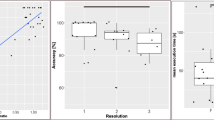Abstract
Conveying spatial information to visually impaired people is possible by leveraging residual tactile abilities. It is still unclear how to effectively evaluate mental map construction beyond performance-based metrics. Here we use a minimalistic mouse-shaped tactile device to display tactile virtual objects. We study how task complexity and visual deprivation influence behavioral, subjective and performance variables both in blind and sighted subjects. Complexity shows to be a factor equally affecting both groups. As well we show that performance, amount of acquired information and subjective judgments of task difficulty do not depend on visual deprivation. Results can help with technological solutions in rehabilitation programs for impaired individuals.
Access this chapter
Tax calculation will be finalised at checkout
Purchases are for personal use only
Similar content being viewed by others
References
Brewster, S., Brown, L.M.: Tactons: structured tactile messages for non-visual information display. In: Proceedings of AUIC, vol. 28. Australian Computer Society Inc, Darlinghurst, Australia, pp. 15–23 (2004)
Jay, C., et al.: Using haptic cues to aid nonvisual structure recognition. ACM Trans. Appl. Percept. 5, 8 (2008)
Kyung, K.-U., Lee, J., Park, S., Prahlad, H., von Guggenberg, P.: Flexible visio-haptic display. In: Isokoski, P., Springare, J. (eds.) EuroHaptics 2012, Part II. LNCS, vol. 7283, pp. 206–209. Springer, Heidelberg (2012)
Marquardt, N., et al.: The haptic tabletop puck: tactile feedback for interactive tabletops. In: Proceedings of the ACM International Conference on Interactive Tabletops and Surfaces, ACM, USA, pp. 85–92 (2009)
Rastogi, R., Pawluk, D.T., Ketchum, J.M.: Issues of using tactile mice by individuals who are blind and visually impaired. IEEE Trans. Neural Syst. Rehabil. Eng. 18, 311–318 (2010)
Samra, R., et al.: Design of a tactile instrument to measure human roughness perception in a virtual environment. IEEE Trans. Instrum. Meas. 60, 3582–3591 (2011)
Rastogi, R., Pawluk, D.T., Ketchum, J.: Intuitive tactile zooming for graphics accessed by individuals who are blind and visually impaired. IEEE Trans. Neural Syst. Rehabil. Eng. 21, 655–663 (2013)
Rantala, J., et al.: Methods for presenting Braille characters on a mobile device with a touchscreen and tactile feedback. IEEE Trans. Haptics 2, 28–39 (2009)
Brayda, L., et al.: An investigation of search behaviour in a tactile exploration task for sighted and non-sighted adults. In: Proceedings of Human Factors in Computing Systems, CHI EA 1711, ACM, USA, pp. 2317–2322 (2011)
Brayda, L., Campus, C., Gori, M.: Predicting successful tactile mapping of virtual objects. IEEE Trans. Haptics 6, 473–483 (2013)
R Core Team: R: A language and environment for statistical computing. R Foundation for Statistical Computing, Vienna, Austria (2013)
Hart, S., Nasa-task load index (NASA-TLX); 20 years later. In: Proceedings of the Human Factors and Ergonomics Society Annual Meeting, vol. 50, no. 9, pp. 904–908 (2006)
Author information
Authors and Affiliations
Corresponding author
Editor information
Editors and Affiliations
Rights and permissions
Copyright information
© 2014 Springer-Verlag Berlin Heidelberg
About this paper
Cite this paper
Memeo, M., Campus, C., Lucagrossi, L., Brayda, L. (2014). Similarity of Blind and Sighted Subjects When Constructing Maps with Small-Area Tactile Displays: Performance, Behavioral and Subjective Aspects. In: Auvray, M., Duriez, C. (eds) Haptics: Neuroscience, Devices, Modeling, and Applications. EuroHaptics 2014. Lecture Notes in Computer Science(), vol 8618. Springer, Berlin, Heidelberg. https://doi.org/10.1007/978-3-662-44193-0_37
Download citation
DOI: https://doi.org/10.1007/978-3-662-44193-0_37
Published:
Publisher Name: Springer, Berlin, Heidelberg
Print ISBN: 978-3-662-44192-3
Online ISBN: 978-3-662-44193-0
eBook Packages: Computer ScienceComputer Science (R0)




